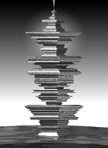| WEN_GRPH: Software for Generating Sets of 384 Numbers |
|---|
| by Peter Meyer |
|
Preface
 In 1994 I developed and published a program called WEN_GRPH, which accompanied the DOS timewave software. This program is designed to take as input any sequence of I Ching hexagrams which satisfy at least some of the properties of the King Wen Sequence and to reproduce the construction as described by Terence McKenna in The Invisible Landscape, the manual for the DOS software, and in Derivation of the Timewave from the King Wen Sequence of Hexagrams. In particular the WEN_GRPH program will generate the standard set of 384 numbers from the King Wen Sequence itself (with the "half-twist"), as well as the "alternate" set (without).
In 1994 I developed and published a program called WEN_GRPH, which accompanied the DOS timewave software. This program is designed to take as input any sequence of I Ching hexagrams which satisfy at least some of the properties of the King Wen Sequence and to reproduce the construction as described by Terence McKenna in The Invisible Landscape, the manual for the DOS software, and in Derivation of the Timewave from the King Wen Sequence of Hexagrams. In particular the WEN_GRPH program will generate the standard set of 384 numbers from the King Wen Sequence itself (with the "half-twist"), as well as the "alternate" set (without).In early November 1997 McKenna announced a "bombshell" on his web site: a claim that mathematician John Sheliak had succeeded in formalizing mathematically, using vector algebra, precisely this construction, so that the 384 numbers could be generated by a single (very complex) mathematical formula. Matthew Watkins had done the same thing, but this time it was claimed that the process of the construction could be expressed from beginning to end in terms of vector algebra.
As a by-product of this work it was announced that the set of 384 numbers given in Appendix II in the original edition of The Invisible Landscape had embodied an error, namely, it had incorporated a step for which there was no justification (as Matthew Watkins himself had pointed out quite clearly). This was the "half-twist", whose existence I had previously revealed in the original version of the documentation (published in 1994) in a footnote in the DOS software manual.
| Home Page |